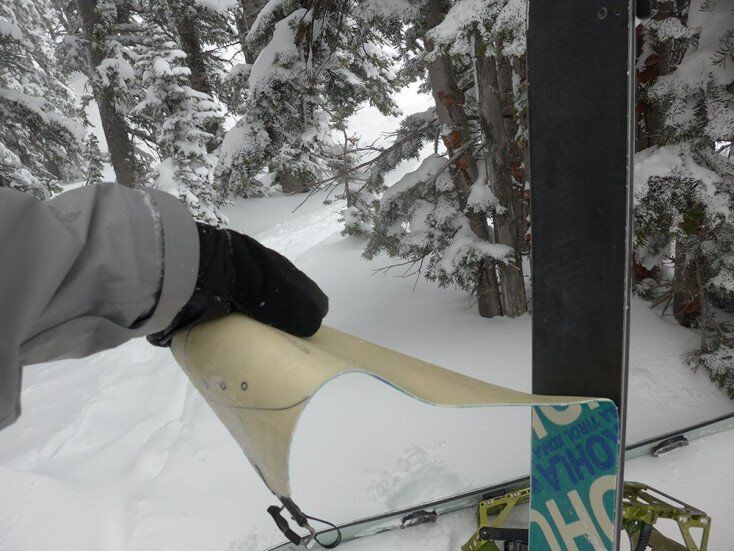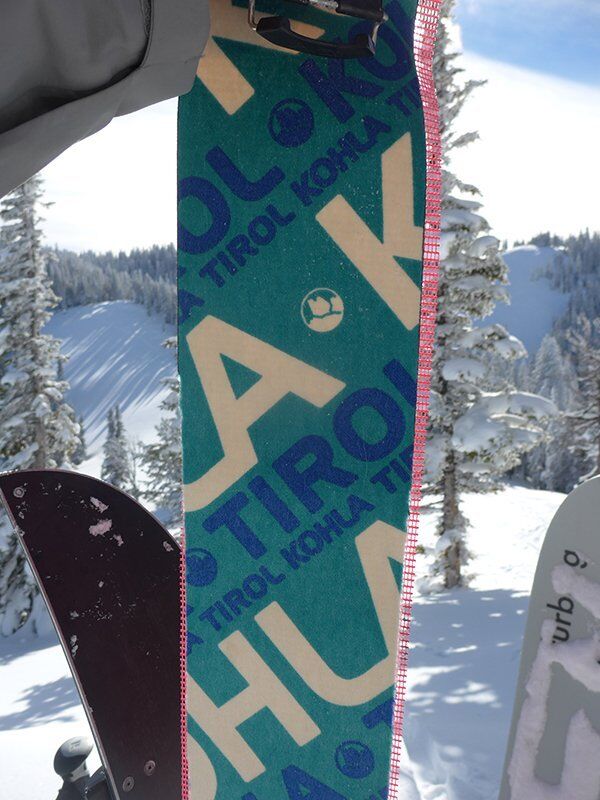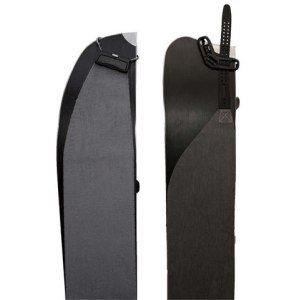Kohla Peak Mixmohair Splitboard Skins Review
There is nothing more frustrating than skins that don’t bite. The track gets slippery and steep and the switchbacks take twice as much effort. Especially true in spring when fighting your way up the hard-packed superhighway of Garnet Canyon, where I took these last year on a trip up to the Chouinard Couloir in the Middle Teton. The only thing is, these Kohla Peak Mixmohair Skins held on much longer than my partner’s as he powered his skis uphill, from icy track all the way to tricky avy debris.
65% Mohair / 35% Synthetic
As they had the weekend before when I encountered basically every type of snow, from pow to ice to crust to crud to rot heading up Taylor. As they had on Mike’s delicious pow fests earlier in the winter when he started touring on them. And they even held up on my June mission up Jackson peak, an approach that’s just as mixed and dirty and melted out as you could imagine a June approach would be. Amazing. And that’s why, from first wear, they immediately became my favorite skins.

Science. That’s what will make America great again — lots of science. Like these Kohlas, 65% mohair and 35% synthetic. See, skinning comes down to glide and traction. It’s frustrating and energy-sapping to slip back; it’s almost as energy-sapping and frustrating to not be able to glide forward.
Mohair is easier to glide but you sacrifice traction; synthetic fibers optimize traction but, as you can probably deduce from this little rundown, it’s tougher to glide. With a mohair/synthetic mix, you get the best of both worlds and across the most variable conditions. And depending on the depth and mix of the fibers, the mix can actually become a stronger beast than either individually. Kohla’s mix and length deliver just this and in spades.
How Compact Are the Skins?
They also use less material and less adhesive. This means your skins are easier to separate at those early morning trailheads. It also means they can roll up to smaller than a beer can and you can shove them into even the most-overfull backpacks because, hell, Backcountry 101 means you need to be prepared for every occasion and as you learn more about the what ifs, you realize you need more on your back.

What can be Improved?
Of course, there will be a few issues in technology so soon. That’s science.
When Mike first took them out, he accidentally put them on backwards because there isn’t much visual difference between tip and tail so make sure your practice a few times beforehand to figure them out and then maybe give a little marking so your sleep-deprived, half-frozen head doesn’t forget at 5 AM in the parking lot.
Also, it has rubber connectors on the nose and tail clips. They had moved around a few times when I pulled them tight over my split until one time, a tail clasp just came off. So far, the metal end around the end works fine but we’ll see down the line.

These skins require a bit more care than big synthetics with globs of adhesive. Sometimes I’ll be lazy and stretch my skins on my split, then throw them in my truck for a long drive (or even overnight if it’s a super-early start). Having done that before a recent tour, they did fine on the approach. However, after riding down and having to put them back on the splits, I had a glue fail. It was a bonehead mistake (and probably had at least a little to do with residual dirt on the skins from my trip up Jackson Peak). But something just to note. Big boy (or girl) skins require big boy (or girl) care.
Kohla Peak Mixmohair Splitboard Skins Pros & Cons
Pros:
- Best of both worlds with mohair/synthetic mix
- Compact, rolls smaller than a beer can
- Superior grip and glide for uphill travel
Cons:
- Some visual difficulty distinguishing tip and tail.
- Rubber connectors on nose and tail clips can move.
- Requires more care compared to big synthetics.
Overall Impression

Those Europeans are years, if not a decade, ahead of us when it comes to ski and split mountaineering. It’s a lifestyle out there and it’s been so since we were mostly content to slip out of bounds and call it backcountry. There are ski-trading routes through the mountains, villages that for centuries were ski in/ski out. Ski mountaineering isn’t a branch off what most of the people who live in the mountains do; it’s what most of the people who live in the mountains do in general, period.
It would make sense, then, that after a split career of using (and, admittedly, being mostly happy with) American companies’ skins, I would step onto a pair of Tirolean Tank Treads and fall in love. With superior grip and glide and decreased weight and bulk, Kohla’s finally given uphill traffickers the future.
Do yourself or the one you love a favor this Christmas: Get the gift of bomber uphill travel. Because Kohla seems to understand better than any other company: You gotta get up quick to get down fast. The Kohla Mixmohair Skin ($179.99) is one of the best splitboard skins out there.
-

 Telos Snowboards
Telos Snowboards$224.95$112.47Buy Now -

 Amazon US$193.00Buy Now
Amazon US$193.00Buy NowAmazon.com Price: $193.00 (as of 12/19/2025 01:53 MST) Details
Product prices and availability are accurate as of the date/time indicated and are subject to change. Any price and availability information displayed on Amazon.com at the time of purchase will apply to the purchase of this product.
-

 PRFO Sports$ 299.99 (CAD)Buy Now
PRFO Sports$ 299.99 (CAD)Buy Now -

 evo$1,028.98Buy Now
evo$1,028.98Buy Now


Hi! I’ve had these skins since last Feb. They’ve been great. However recently it’s been a colder, snowier winter and they have been failing a lot. Any tips for helping restore the glue (which is now embarrassingly dirty) or for what I can do day to day? I use them daily for work and usually transition multiple times a day.
Hi Ashley,
These skins are super light. As such, they don’t have a lot of glue and considering they’re made in Europe, there might be a little R&D divide since their winters aren’t on average as cold or deep as ours in the US. That said, You should probably renew the glue every season. I did that last November (’17) and they are still holding, though a recent trip showed me it might be time to do it again soon. There are plenty of tutorials for how to clean and reglue your skins, but here are some broad strokes:
1. If they’re just super dirty, try washing them in your sink and then drying them with a hairdryer. That can sometimes reactivate the glue.
2. If the glue is just clumped up, you can use thick wax paper and an iron to try and flatten it out (though this can be a little tricky, especially when taking the wax paper off). Thin Wax paper will likely rip when you try to peel it off in one sheet and you’ll have little pieces of wax paper attached to your skins, which becomes very tedious to pick off.
3. What I did (and will do again) is use paper shopping bags and an iron to essentially melt off all the old glue (and then I use a card to scrape off residue). Then I apply a tube of Black Diamond Gold Standard and they’re like brand new.
-Ryan